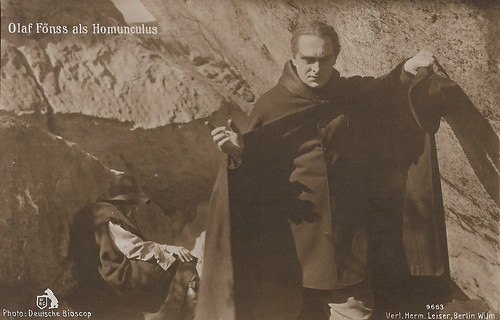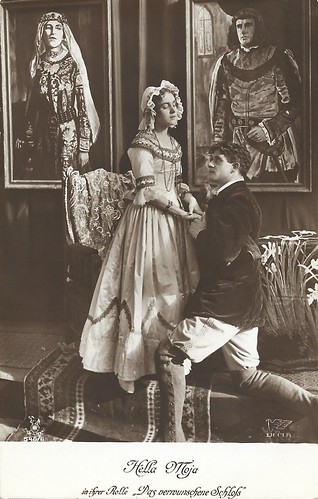
German postcard by Verlag Hermann Leiser, Berlin, no. 9665. Photo: Deutsche Bioscop. Olaf Fønss in Homunculus (Otto Rippert, 1916).

German postcard in the Film-Sterne series by Rotophot, no. 547/1. Hella Moja in the German silent film Heide-Gretel (Otto Rippert, 1918), produced by the Decla-Filmgellschaft (Eric Pommer). Cinematography was by Carl Hoffmann, and the script by Carl Schneider. Moja's male co-actors were Max Ruhbeck and Leopold von Ledebur. The film premiered at the Berlin Marmorhaus cinema in February 1918.

German postcard by Rotophot in the Film Sterne series, no. 548/1, 1919-1924. Photo: Decla. Ressel Orla and Emil Birron in Das Glück der Frau Beate / The luck of the Mrs. Beate (Alwin Neuß, Otto Rippert, 1918).

German postcard in the Film-Sterne series by Rotophot, no. 555/5. Photo: Decla. Charlotte Böcklin in Der Weg, der zur Verdammnis führt, I. Das Schicksal der Anne Wolter (Otto Rippert, 1918). The man may be the white slave trader Ignaz Czyslow (Guido Herzfeld).

German postcard by Ross B.-V.-G., Berlin. Photo: Decla. Theodor Becker as Franziskus in the catacombs in Pest in Florenz/The Plague in Florence (Otto Rippert, 1919).
The second film made about the sinking of the Titanic
Otto Rippert was born in 1869 in Offenbach am Main, Germany. Rippert made his debut in Meißen in 1889. He worked at theatres in Eisleben (1892), Riga (1893) and Munich (1894), where he directed for the first time in 1898. In 1899, he worked in London, then in Nuremberg and in 1906 in Baden-Baden. From 1907 to 1910, he worked as an artistic theatre director, first in Forst in Lausitz (Lusatia) and then at the Bamberg State Theatre.
Rippert came into contact with film more by chance. In 1906, a film crew for the French Gaumont Film Company visiting Baden Baden was looking for a director at the local theatre. They were referred to Otto Rippert, who took on a leading role as well as directing. It was his first film, but it wasn't until the next decade, when the medium began to grow beyond the former fairground attraction, that Rippert turned to film full-time.
In 1911, Rippert went to Berlin. In 1912, he appeared, complete with a stick-on beard, as the millionaire Isidor Straus in the film In Nacht und Eis / In Night and Ice (Mime Misu, 1912), about the sinking of the Titanic. It is the second film made, and the first surviving one, about the disaster. With a running time of 35 minutes, In Nacht und Eis was three times longer than the average film of 1912. Shot in black and white, various scenes were tinted to heighten their impact, such as night scenes in dark blue and a shot of a stoker feeding a burner in red.
In Nacht und Eis / In Night and Ice was made by Continental-Kunstfilm of Berlin, where Rippert continued to work as a director. He had his breakthrough as a director with the short silent melodrama Gelbstern (Otto Rippert, 1912), with Thea Sandten in the leading role. Rippert made some ten films for Continental-Kunstfilm between 1912 and 1914, most of which are considered lost.
In the 1910s, Rippert became one of the most productive German directors. However, his reputation as one of the pioneers of German silent film rests on some of his later achievements, his masterpieces Homunculus, Pest in Florenz / The Plague of Florence and Der Totentanz /The Dance of Death.

German postcard by Verlag Hermann Leiser, Berlin, no. 9663. Photo: Deutsche Bioscop. Olaf Fønss in the German film Homunculus (Otto Rippert, 1916).

German postcard by Verlag Hermann Leiser, Berlin, no. 9924. Eva Speyer and Carl de Vogt in Friedrich Werders Sendung (Otto Rippert, 1916), scripted by Hugo Landsberger. This was one of the first films of De Vogt, who played the title role, while Speyer played his wife.

German postcard by Rotophot in the Film Sterne series, no. 501/3. Photo: Decla. Hella Moja and Theodor Loos (far left) in the German silent film Die das Glück suchen / Those Searching for Happyness (1917). Oddly, this title does not appear in the databases Filmportal.de and IMDb. Yet, an announcement in Der Kinematograph of 1918 and earlier remarks in Der Lichtbildbühne of 1917 suggest the film did exist, was directed by Otto Rippert and scripted by Paul Otto. By looking at the numbers of the Film-Sterne series, the film must date from 1917. It is not clear when the film was made or if the film was released. Other actors mentioned as playing in the film were Hermann Thimig (who might be the doctor-like figure on our other card of the film), Anderly Lebius, and Otto Lins-Morstadt. Cinematography was by Max Fassbender. Thanks to Jean Ritsema for this information.

German postcard in the Film Sterne Series by Rotophot, no. 511/2. Photo: Decla. Hella Moja in Die Tochter der Gräfin Stachowska (Otto Rippert, 1917), produced by Erich Pommer.

German postcard by Rotophot in the Film-Sterne series, no. 546/6. Photo: Decla. Hella Moja as Veronika and Carl Auen as Gontard in Das verwunschene Schloß / The Haunted Castle (Otto Rippert, 1918).
Mad scientists, superhuman androids and sinister technology
Otto Rippert's Homunculus (1916) is a six-part serial science fiction film involving mad scientists, superhuman androids and sinister technology. Danish star Olaf Fønss (aka Olaf Fönss) stars as Homunculus. The script was written by Robert Reinert, and the film was originally produced by Deutsche Bioscop GmbH. Reinert's script is loosely based on the epic poem 'Homunculus' written by Robert Hamerling in 1888.
The subject of a monstrous man-made being turning against its creator is similar to Der Golem (Paul Wegener, 1915) and Alraune (Henrik Galeen, 1928). It also reminds me of Mary Shelley's 'Frankenstein', wherein a living creature, called a homunculus, is created artificially in a laboratory and strives to develop emotions like a human being. The serial also foreshadows various elements of Metropolis (Fritz Lang, 1927). It also served as a model for Frankenstein (James Whale, 1930) rather than the original silent adaptation of Shelley's novel, Frankenstein (1909), directed by Thomas Edison.
Fritz Lang wrote the script for Rippert's historical epic Pest in Florenz / The Plague of Florence (Otto Rippert, 1919) for Erich Pommer's Deutsche Eclair (Decla) production company. The screenplay was written by Fritz Lang. The film is a tragic romance set in Florence in 1348, just before the first outbreaks in Italy of the Black Death, which then spread out across the entire continent. It was the first film to feature the black plague. Pest in Florenz is an allegorical drama, which belongs to the best work of Rippert. It is a visual party with beautiful sets and costumes. Lang's screenplay was based on the Edgar Allan Poe story 'The Masque of the Red Death', but he heightened the story's sexual tension by making the plague the result of the actions of a young seductress. The cameraman was Emil Schünemann, who was behind the lens for In Nacht und Eis.
That same year, Rippert also directed a silent Horror film for Erich Pommer, Der Totentanz /The Dance of Death (Otto Rippert, 1919), written by Fritz Lang and starring Werner Krauss and Sascha Gura. His other films included Die Frau mit den Orchideen / The Woman with Orchids (Otto Rippert, 1919) starring Carl de Vogt, Werner Krauss and Gilda Langer, the historical film Gräfin Walewska / Countess Walewska (Otto Rippert, 1920) starring Hella Moja, and Die Beute der Erinnyen / The Prey of the Furies (Otto Rippert, 1922) starring Werner Krauss and Dary Holm. After 1924, Otto Rippert stopped directing films. He went to Breslau to work as a theatre director, then to Munich. From the end of the 1920s until 1939, he worked as a sound editor. In 1937, he had a stroke, and Rippert died of the after-effects in Berlin in 1940. He was 70.
After Deutsche Bioscop merged in spring 1920 with Decla-Film to form Decla-Bioscop, Homunculus was heavily edited down to three parts and re-released with colored tints and intertitles in September 1920. Only the original chapter 4 and a fragment of chapter 5 from the series were still extant. Nearly a century after Homunculus premiered, the head of the Munich Film Museum, Stefan Drößler, retrieved 27 reels of the six original chapters released in 1916/1917 from a Moscow film archive. They had been heavily cut up and jumbled, with the intertitles excised, but a restored version lasting 196 minutes was shown in August 2014 at the Rheinisches Landesmuseum Bonn as part of the Bonn Silent Film Festival.

German postcard in the Film-Sterne series by Rotophot, no. 547/5. Photo: Decla. Hella Moja in Heide-Gretel (Otto Rippert, 1918). The man at left could be Leopold von Ledebur, the Prince in the film.

German postcard by Rotophot in the Film Sterne series, no. 548/8. Photo: Decla. Ressel Orla in Das Glück der Frau Beate/The Luck of the Mrs. Beate (Alwin Neuß, Otto Rippert, 1918).

German postcard by Rotophot in the Film-Sterne series, no. 555/8. Photo: Decla. Charlotte Böcklin in Der Weg, der zur Verdammnis führt, I. Das Schicksal der Änne Wolter (Otto Rippert, 1918). Der Weg, der zur Verdammnis führt (The Road to Damnation, 1918) was a two-part film directed by Otto Rippert, of which the first part was called Das Schicksal der Änne Wolter / The Fate of Änne Wolter and the second part Hyänen der Lust / Hyenas of Lust. In the first part, Anne Wolter (Charlotte Böcklin) falls into the hands of scheming white slave traders. In the second part, two other girls fall into the hands of the white slave traders, the two naive girlfriends, Ilse von Giersdorf (Käthe Haack) and Lilly Gross (Grete Weixler).

German postcard by Ross B.-V.-G., Berlin. Photo: Decla. Publicity still for the historical drama Pest in Florenz/The Plague in Florence (Otto Rippert, 1919). On the right is the Cardinal, played by Franz Knaak.

German postcard by Ross B.-V.-G., Berlin. Photo: Decla. Publicity still for the German historical drama Die Pest in Florenz/The Plague in Florence (Otto Rippert, 1919). The back of the card has a Spanish imprint. The arrival of the beautiful courtesan Julia (Marga von Kierska) in late medieval Florence causes a stir at the political establishment. Mayor Cesare (Otto Mannstaedt) cannot resist the lady, nor can his son, Lorenzo (Anders Wikman). When the woman is about to be tortured, the son kills his father and transforms the churches into dens of iniquity. Corruption and evil rule. Soon after, the city gets to deal with the Plague (Julia Brandt).
Sources: Filmportal (German), Wikipedia (German and English) and IMDb.
No comments:
Post a Comment